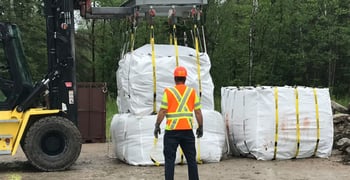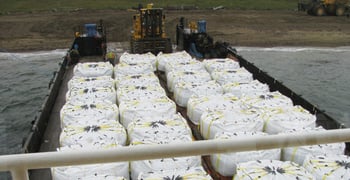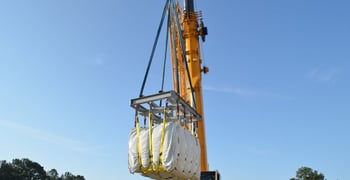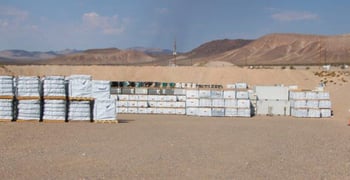What drives your selection of waste containers for radioactive waste? The variety of radioactive waste container types reflects the different types and sources of radioactive waste requiring collection, transport, and disposal. The containers are not a one-size-fits-all solution because radioactive waste includes various contaminated solid and liquid materials generated from nuclear plants, mining operations, hospitals, research institutions, environmental services, and industrial processes. Radioactive gaseous waste is also generated. Selecting the right option is vital for many reasons, including the need to meet rigorous federal, state, and local radioactive waste containment and disposal regulations (to avoid significant fines for non-compliance) and safeguard your employees' health and safety.
Radioactive Waste Regulations Determine Best Container
Waste includes industrial waste, municipal solid waste, hazardous waste, radioactive waste, agricultural waste, and more. There is leeway with some non-radioactive waste in terms of waste containment selection. Radioactive waste is subject to strict federal regulations, and several agencies regulate the identification, containment, transport, and disposal of this type of waste.
- U.S. Nuclear Regulatory Commission (NRC).
- Environmental Protection Agency (EPA)
- Department of Energy (DOE)
- Department of Transportation (DOT)
- Occupational Safety and Health Administration (OSHA)
- United Nations (UN)
Each agency has a specific role in managing radioactive waste, but the type of container the radioactive waste is placed is essential to meeting all agency requirements. The containers are designed to ensure there is no leakage of radioactive material at any stage of normal handling to protect human health and the environment.
PacTec Specializes in Low-Level Flexible Waste Containers for Radioactive Material
PacTec specializes in low-level flexible waste containers for radioactive waste. Low-level radioactive waste is one of three classifications or types of radioactive waste, with the others being high-level and intermediate levels. There are also three classes of radioactive material based on the amounts of radioactive elements in the waste material.
What Goes in a Low-Level Radioactive Waste Container?
When choosing the best containers for radioactive waste, the specific identification of the type and class of radioactive waste is critical to meet federal guidelines.
- Low-level Mixed: LLMW contains both low-level radioactive waste and Resource Conservation and Recovery Act (RCRA) hazardous waste. It is mainly generated at industrial facilities, hospitals, energy laboratories, and nuclear power plant facilities. It does not include waste like spent nuclear fuel. Examples include contaminated clothing, tools, equipment, filters, and syringes.
- Low-level Waste, Low Specific Activity I: LLW LSA-I refers to radioactive materials that are not fissile (able to undergo nuclear fission) and have limited specific activity related to radionuclides. This category includes contaminated soil, construction debris, and metal waste.
- Surface Contaminated Objects: SCO-I materials are non-radioactive materials contaminated with fixed or removable (non-fixed) radioactive material. It includes items like tools, cabinets, computers, and benchtops. It also includes construction debris, construction rubble, and metal waste.
- Low-level Waste, Low Specific Activity II: LLW LSA-II includes water with a tritium concentration of up to .8 TBq/L and other radioactive material. The activity is distributed throughout, and the average specific acidity does not exceed 10−4 A2/g for solids and gases and 10−5 A2/g for liquids.
- Surface Contaminated Objects: SCO-II includes non-radioactive materials contaminated with fixed or removable radioactive material. SCO-II contamination limits exceed the legal limits for SCO-I.
- Low-Level Waste, Low Specific Activity III: LLW LSA-III includes solids, excluding powders. This level comprises radioactive material that is relatively insoluble. The radioactive material is distributed throughout the solid or collection of solids or is uniformly distributed in a solid compact binding agent. Examples include concrete, ceramic, and bitumen. Even if packaging allows the contents to escape, the amount of radioactive material leached, if placed in water for seven days, would not exceed 0.1 A2. A third item is a low-level waste solid with an average specific activity that does not exceed 2 X 10-3 A2/g.
Tips for Choosing the Right Container for Your Radioactive Waste
Using the information outlined so far, it is time to assess the specifics of the waste you want to contain or dispose of. The following are some questions to ask and answer to determine the best containers for low-level radioactive waste:
1. How much waste are you trying to contain or dispose of?
The amount of radioactive waste refers to both the quantity and how much the waste will expand and contract with heat. Flexible containers for LLMW materials accommodate fluctuations, unlike rigid containers. The amount of waste impacts the size of the containers you can use. Certain types of waste require you to use a minimum-sized container for storage and transportation. Of course, liquid radioactive waste disposal containers are uniquely designed compared to containers that hold solid materials.
2. What type of material is right for your radioactive waste type?
The four waste types and the waste classifications described earlier will directly influence the type of containment material. You want to make sure the waste will not react with the container. Containment products for radioactive materials are designed with multiple layers for this reason. Low-level waste is typically stored on-site by the company until it decays to a certain level and can be sent to a low-level disposal site. Containers must accommodate storage and transport. You will consider the end-to-end cycle of radioactive waste. PacTec customers attest that flexible packaging is superior to rigid containment in many ways.
3. Is flexible waste packaging allowed for some nuclear waste types?
For many kinds of radioactive waste, rigid packaging is not needed. You can use flexible packaging made from the highest-rated polymeric materials, making them less expensive than rigid containers. They also cost less to pack and transport.
4. Does your packaging need to be DOT approved?
If you're planning on transporting your radioactive materials, the packaging must meet the Department of Transportation (DOT) approval. Packaging is tested and certified by the DOT or approved certifying organization.
5. Will you be transporting your materials?
The Department of Transportation regulates the transport of radioactive waste materials. Regulations include identifying radioactive materials, packaging, packaging closures, storage, and packaging labeling. Compliance is essential to avoid fines.
Types of Radioactive Waste Containers
It is critical to select suitable packaging to meet strict Federal regulations for packing, storing, and transporting radioactive waste. The best way to reduce risks is to ensure you follow packaging standards established by the various government agencies mentioned earlier.
What is a radioactive waste container? There are three major categories.
- Excepted packaging: This is packaging for waste with extremely low levels of radioactivity. The radioactive waste poses a low hazard even if released. An example is smoke detectors which have a small amount of the radioactive material americium-241. Excepted packages are excluded from specific packaging, labeling, and shipping paper requirements but must have UN letters and UN identification numbers on the outside. Requirements are found in 49 CFR 173.421.
- Industrial packaging (strong, tight containers): Contents can be protected from leakage or spillage during normal handling and transportation activities with this type of packaging. Examples of eligible materials include slightly contaminated clothing and tools, and smoke detectors. The packaging is marked on the outside to meet regulations in 49 CFR 173.411.
- Type A Packages: Radioactive materials with higher specific activity levels and present a higher hazard level if contents are released are shipped in this packaging. The packaging must withstand moderate degrees of cold, heat, water spray, penetration, and stacking tests. It does not have to withstand an accident. Materials include nuclear medicines, industrial products, and radioactive waste. Type A packaging is specially constructed to hold a limited quantity to limit potential consequences should the material be released. The packaging must undergo a series of tests without releasing the contents, proving it can shield the contents during transport of radioactive waste. Type A packaging must meet regulations in 49 CFR 173.412.
- Type B Package: Radioactive materials with an even higher specific activity than materials shipped in type A packages are shipped in Type B packages. The packaging can be small or large. If released, the materials qualifying for this type of packaging would present a severe radiation hazard to the environment or public.
Packaging is tested for its ability to withstand normal shipping conditions and a severe accident without breaking. This packaging is used for radioactive material like spent nuclear fuel, high-level radioactive waste, and waste with high concentrations of radioactive elements like cobalt and cesium. Packaging must meet requirements in 49 CFT 173.411, 49 CDFT 173.413, and 10 CFR 71.
PacTec Radioactive Waste Flexible Containment Solutions
With all this information, you can better understand how to select radioactive containment packaging. The following are examples of PacTec products to give you an idea of the containers for low-level radioactive waste.
PacTec packaging meets industrial packaging and Type-A packaging and offers packaging for very low-level mixed waste that includes radioactive debris.
Type IP-1 LiftPac®

The IP-1 LiftPac® flexible containment packaging can be easily handled and adequately secured while in or on a transport vehicle. The LiftPac® can withstand the effects of normal transportation vibrations without breaking, so contents cannot escape. It is ideal for LLW LSA-1 and SCO-1 Low-Level Waste, demolition debris, contaminated soils, and metal waste. Packaging is also DOT compliant. PacTec also has the UN Certified IP-1 LiftPac, which has an integrated rigid corrugated fiberboard box and a 6ml PE bag/liner.
Type IP-2 LiftPac®
 The IP-2 LiftPac® flexible containment packaging is also easily handled and can be properly secured for transport. It is ideal for radioactive materials for LLW LSA-II and SCO-II, including radioactive soil, sand, gravel, and construction materials. The IP-2 packaging has met government testing requirements to prevent the loss or dispersal of the radioactive contents. It also prevents a significant increase in radiation levels recorded before testing.
The IP-2 LiftPac® flexible containment packaging is also easily handled and can be properly secured for transport. It is ideal for radioactive materials for LLW LSA-II and SCO-II, including radioactive soil, sand, gravel, and construction materials. The IP-2 packaging has met government testing requirements to prevent the loss or dispersal of the radioactive contents. It also prevents a significant increase in radiation levels recorded before testing.
7A Type A IP-3 LiftPac®
 The 7A Type A IP-3 LiftPac® meets all the Type IP-1 and Type IP-2 packaging requirements plus more stringent requirements for testing. It provides additional shielding that can withstand the static and dynamic stresses resulting from transport and prevents more than a 20 percent increase in the radiation level. It is suitable for soil, sand, gravel, construction debris, and LSA-III Low-Level Waste.
The 7A Type A IP-3 LiftPac® meets all the Type IP-1 and Type IP-2 packaging requirements plus more stringent requirements for testing. It provides additional shielding that can withstand the static and dynamic stresses resulting from transport and prevents more than a 20 percent increase in the radiation level. It is suitable for soil, sand, gravel, construction debris, and LSA-III Low-Level Waste.
Macrobag®
 The PacTec MacroBags® are flexible RCRA radioactive waste containers for LLMW cleanup and meet DOT shipping regulations. They also meet the Land Disposal Restrictions (LDR) for disposal. With the MacroBag®, a low-level waste container, you can meet the regulations for low-level radioactive debris and mixed waste while gaining numerous benefits for your company at the same time.
The PacTec MacroBags® are flexible RCRA radioactive waste containers for LLMW cleanup and meet DOT shipping regulations. They also meet the Land Disposal Restrictions (LDR) for disposal. With the MacroBag®, a low-level waste container, you can meet the regulations for low-level radioactive debris and mixed waste while gaining numerous benefits for your company at the same time.
Radioactive Waste Containers Deliver Efficiency, Cost Savings, and Regulatory Compliance
What is radioactive waste? Quite simply, it is waste with properties that make it harmful to humans and the environment, so it requires specialized end-to-end containment. PacTec solutions deliver efficiency in loading, containing, storing, and transporting low-level radioactive materials, offering cost savings through careful design that ensures maximum usage and regulatory compliance.




